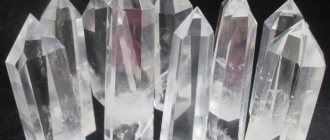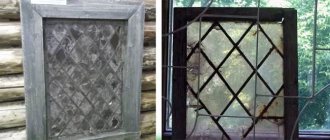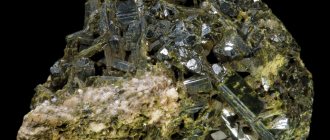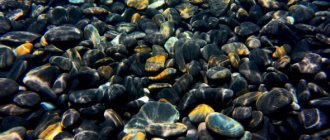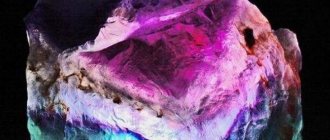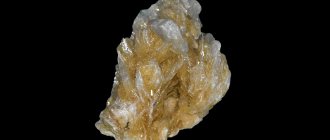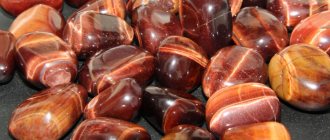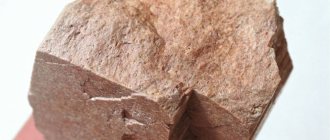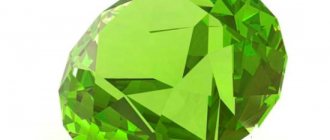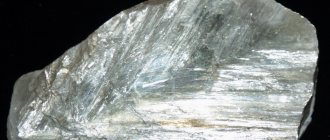Story
Linguists believe that the name comes from the word “layer”.
The history of the mineral is connected with Russia:
- In Rus', he was called “sluda,” which was recorded in the Ostromir Gospel (1057).
- After 500 years, windows made of “Moscow crystal” could be afforded by nobles, merchants, and wealthy church parishes.
- By the 17th century, mica windows began to be painted like stained glass windows in Western European temples.
- Even more popular were lampshades, lanterns, mineral inlay boxes, and other household items.
- Mica plates were used to protect icons and decorate church utensils.
Mica, called muscovite (foreigners then called Russia Muscovy), was considered the best in the world.
Mining the mineral was a profitable business: 16-140 rubles were paid for a pood (16 kg). And, for example, a cow cost 4-5 rubles.
Windows were “glazed” with mica plates before the invention of real glass (18th century).
Mica instead of glass
In 1887, Russian scientist Konstantin Khrushchev created artificial mica - fluorphlogopite. In a number of characteristics it is superior to natural gemstones. Only special equipment can distinguish one from the other. The invention was useful during the Great Patriotic War.
The most remarkable object outside of Russia is the Mexican city of gods Teotihuacan. Its buildings are lavishly decorated with minerals that were brought here 5,000 km away.
Origin and location
A common, chemically stable mineral.
Among the minerals of the mica group, it is widely distributed. As a rock-forming mineral, it is included in the composition of some intrusive rocks, in particular, in the composition of granites, especially greisen, i.e., pneumatolytically altered varieties of them, in association with topaz, lithium mica, quartz, sometimes wolframite, cassiterite, molybdenite, etc. In these cases, muscovite is formed mainly due to previously released potassium feldspars (orthoclase and microcline).
Relatively often found in granite pegmatite veins in the form of large crystals of industrial interest. Muscovite in such veins, especially in the central parts, often produces clusters in the form of nests up to 1–2 m in diameter, but is usually randomly scattered in the form of large crystals throughout the entire mass of pegmatite or along certain zones.
Zircon, rutile in the form of a saguenite lattice, apatite, spinel, garnets, tourmaline, quartz, magnetite, etc. are sometimes found as tiny inclusions in muscovite crystals. With a detailed study, in some cases, it is possible to establish certain patterns of orientation of these inclusions in accordance with the structural features of the minerals.
Muscovite is rare in contact-metasomatic deposits. There are known cases of the formation of fine-grained muscovite in sandstones at their contact with granites and other acidic igneous rocks.
Under hydrothermal conditions, sericite is usually formed due to the decomposition of spars (sericitization, i.e. the formation of sericite - a cryptocrystalline variety of mica enriched in water): 6KAlSi3O8 + 4H2O + CO2 + ZAl2O3 -> 4KAl2[AlSi3Oi0](OH)2 + K2CO3 + 6SiO2. Sericite is stable in neutral (weakly acidic or slightly alkaline) solutions at relatively high temperatures, while in more acidic solutions pyrophyllite and kaolinite are formed instead; the latter is a lower temperature mineral.
In metamorphic rocks, muscovite and sericite are widespread. Entire massifs of mica crystalline schists, sericite-containing shales (phyllites) and quartzites with muscovite are known. In such rocks, feldspars are usually absent, because being the initial source for the formation of muscovite micas under conditions of regional metamorphism.
During weathering processes it is relatively chemically resistant and often turns into placers. Due to its ability to easily split into small leaves and due to its low specific gravity, it usually accumulates in the form of tiny silvery sparkles in silty sediments and layered clays formed in water basins with slow water movement.
Under conditions of intense chemical weathering, muscovite is capable of transforming into hydromicas richer in water - hydromuscovite, and when passing into an alkali solution - into kaolinite.
What is mica
This is a rock of volcanic or metamorphic origin. In nature it is represented by agglomerates of yellow, green, pink shades. Thanks to its layered structure, it is easy to distinguish from other minerals and synthetic imitation.
It is found in other rocks. For example, spar, mica and quartz form granite.
In aventurine, a precious variety of quartz, it is mica that creates the characteristic sparkles.
Application of muscovite in industrial production
Muscovite is an excellent dielectric, widely used as a direct current insulator. Large-crystalline varieties of stone are used in the production of radio and electrical goods. The mineral is used in the creation of modern energy plants. Electrical insulating gaskets made from it are used in the manufacture of electrical devices. Muscovite sheet serves as a raw material for the production of capacitors and telephones.
Mica is used to make powder, which is subsequently used to make building materials, heat-resistant paints, car tires and glass, mica cardboard, wallpaper, and writing paper. Mica-muscovite is a component of grinding stones and lubricants. In the metallurgical industry, windows for blast furnaces are made from the mineral.
The use of mica is a necessary condition for the creation of mycalex, a heat-resistant material obtained from a mixture of muscovite and fusible glass. Its use makes it possible to create circuit boards, inductor combs, high-power lamp holders and other parts used in modern electrical and radio equipment.
Physico-chemical characteristics
Mica is a whole family of minerals with a general formula. But each has its own melting point, density and other characteristics.
General formula: X+Y23+[AlSi3O10](OH, F)2 , less often X+Y32+[AlSi3O10](OH, F)2 , where X is mainly K, less often Na, NH4, Y is usually Mg, Fe, Al, less commonly Ba, Mn, Ca, Ti, Zn, B, V, UO2.
According to chemical nomenclature, it is an aluminosilicate (like, for example, feldspar).
Varieties of mineral
Based on composition, color, and other characteristics, the following main varieties of the mineral are distinguished:
- Biotite. Ferrous, opaque, black to brownish-green.
- Lepidolite. Translucent plates look like curved petals, sometimes forming “buds”-rosettes. Standard colors are lilac, pinkish-lilac, with faded yellow or grayish tint, colorless.
- Muscovite. The most common type. Colorless or whitish, half or completely transparent mica plates.
- Phlogopite. Yellow, sometimes brown. In the light, the “leaf” glows with golden or ocher hues. Second most common.
They are always mentioned when describing a specific sample or batch of mica raw materials.
Varieties are arranged according to the dominance of elements in the composition. Thus, paragonite and muscovite are aluminum mica. Biotite, phlogopite, lepidomelane – iron-magnesium, zinnwaldite and lepidolite – lithium.
Properties
Although the mineral may contain different elements, its basic characteristics apply to all varieties. Properties are conventionally divided into physical, chemical and medicinal.
Physical and chemical
Mica has a number of characteristics that combine minerals of different compositions:
- cleavage - the crystal is easily divided into thick plates in any direction;
- flexibility;
- softness - a small impact leaves a visible mark on the stone;
- strength;
- resistance to high temperature and radiation;
- hygroscopicity - the ability to absorb water.
Also, layered rock has the following properties:
- bends at an angle of 90°;
- has a mixed color with different shades;
- contains inclusions of other substances;
- has a heterogeneous surface with gas accumulations inside the stone;
- It cracks when pressed hard.
Even after splitting into plates, mica retains its properties.
Medicinal
It is believed that mica of natural origin has a healing effect and has a beneficial effect on the state of the endocrine and hormonal systems. It also acts as an antiseptic for external wounds, promotes their healing and gives the skin a well-groomed appearance. In order for a stone to become medicinal, it must be worn as jewelry on the body constantly or used in powder form, as, for example, in the treatment of skin lesions or acne.
Areas of use
Mica has found use in industry, agriculture, beauty and collectors.
Mica in the microwave
Industry
The properties of mica have determined its demand in almost all sectors of the economic complex:
- Waste from the production of sheet material is ground. The powder is used in the manufacture of rubber, cement, plastics, varnishes, and paints.
- The mineral’s ability to remain an electrical insulator even at extreme temperatures has made it a valuable asset for radio electronics.
Various electrical mica products - In cosmetology, mineral cosmetics are created based on mica powder - creams, powder, blush, eye shadow.
- Vermiculite (expanded mica) is in demand by builders as a thermal insulator filler that maintains its condition for decades.
For farmers, the mica mineral is a “three-in-one” product that increases productivity significantly.
Soil enriched with vermiculite becomes a fertilizer with a complex of microelements, a substrate for growing seedlings, and prevents drying out of wet soil.
Jewelry and decor
The mineral is used to decorate the interior. They decorate panels, furniture, boxes, photo frames. Paints enriched with mica powder make the surface seem to shine from within. It is added to liquid wallpaper and facing plastic.
Mica cabochons become inserts into rings, earrings, pendants, and brooches.
It is popular among restorers who restore items made of ivory, mother-of-pearl, and valuable wood species.
Stone mining methods
Mica occurs naturally in nature, but it can also be grown artificially.
If we talk about natural mining of the mineral, then 2 options are used, depending on the depth of its occurrence:
- Open. Suitable for stones located no deeper than 100 m. In this case, the quarry principle is used, when the top layer of the earth is drilled or exploded with dynamite, high-quality crystals are selected manually.
- Closed (mine). It is used in the extraction of mica at depths from 100 to 4000 m. Shafts and underground passages are laid to the location of the mineral, and the ground around the deposits is exploded or loosened with a drill.
In the process of producing synthetic stone, conditions are created that are as close as possible to natural ones: the temperature is kept within 1400 °C with a gradual decrease to 1200 °C, almost the same components are used as natural mica. The result is a fine crystal suitable for powder or small products.
Therapeutic effect
The properties of the mineral have long been studied and used by Indians and residents of other countries - adherents of the ancient teachings of Ayurveda. They claim that black mica that has been calcined becomes medicinal. The following method is recognized as the best: mica stones are moved over the sacred fire at least two hundred times. This medicine is especially helpful for gastrointestinal problems.
Today lithotherapists also process it - in electric furnaces. But the therapeutic effect of such a mineral is controversial, sometimes zero.
Powdered mica is prescribed to people who are weakened or have contracted an infection.
Magical powers
The magic of mica is determined by the variety or color of the mineral:
- Stones of yellow-brown shades are an attribute of careerists, financiers and those who want to get rich.
- Green muscovite is a regulator of internal harmony.
- Pink is the stone of love . Suitable for people looking for their soul mate or seeking to revive a former passion.
- White or grayish muscovites are worn in cold weather to avoid freezing.
However, only natural mica stone is suitable as a talisman or amulet.
